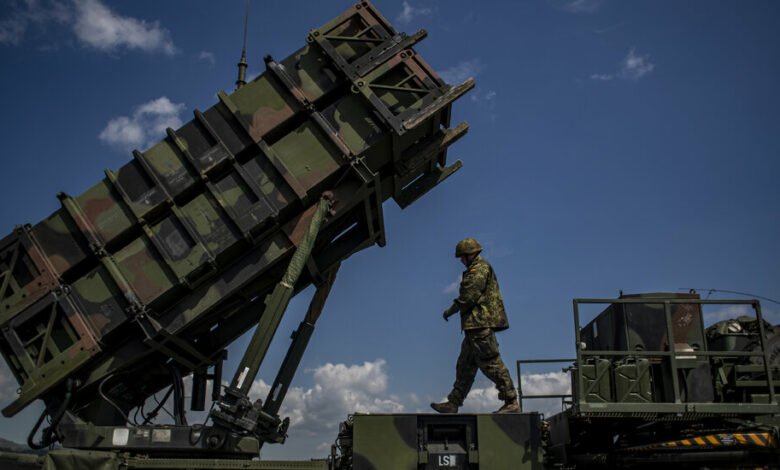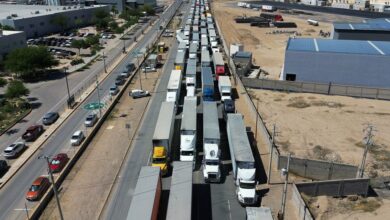Europe tries to solve Ukraine’s ‘Patriot puzzle’

A European plan to equip Ukraine with an additional Patriot air defense system to protect battered cities from Russian airstrikes is gradually taking shape.
The radar and three missile launchers are being supplied by the Netherlands. Some interceptor missiles are coming from a coalition of four countries led by Germany. A mobile fire control center has been promised, but officials will not yet say where or by whom. Additional missiles and launchers, as well as training for Ukrainians to use the advanced system, are being supplied by as many as eight countries.
“We have all the pieces of the puzzle,” former Dutch Defense Minister Kajsa Ollongren said in an interview before she stepped down from office this week as part of a long-awaited transition in the Netherlands’ interim government. “We just need to put them in place.”
It’s the Patriot puzzle, as the assembled air defense system is called by NATO officials.
Ukraine’s President Volodymyr Zelensky has said he urgently needs at least seven Patriot batteries to ward off attacks across the country. President Biden has promised that five Western air defense systems will soon be delivered to Ukraine.
Romania has promised to provide one of its systems, following similar pledges from Germany and Italy. Another is expected from the United States.
The fifth can be delivered via the piecemeal approach. For months, allies have been scouring their arsenals and deciding on a creative, if not certain, way to provide another Patriot system: build one entirely from spare parts donated from across Europe.
“We all have limited options,” said Ms. Ollongren, who came up with the plan after Mr. Zelensky first asked for seven Patriot systems in April. “But if we join forces, I think we can make it happen.”
A spokesman said the Dutch government will continue the efforts under new Defense Minister Ruben Brekelmans, who took office on Tuesday.
All NATO member states are struggling to give up any more of the estimated 90 Patriot batteries that are scattered across the military alliance, according to weapons trackers at the International Institute for Strategic Studies in London — two-thirds of them in the hands of the United States. For smaller European nations that can’t afford the $1 billion-plus systems, donating even one of their stockpiles poses a risk to their own national defenses.
Still, offering Ukraine additional air defenses is likely to be one of the few tangible commitments the allies will announce next week at a high-level meeting of NATO leaders in Washington — a promise that will only partially appease Mr. Zelensky.
“They know that we urgently need seven Patriot systems – yes, to save our cities,” Mr Zelensky said. said on a press conference with Mr. Biden at the Group of 7 meeting in Italy last month. “And we discussed the possibility of having five, that’s true.”
“That doesn’t mean that we will have these five systems tomorrow, but we see good results for Ukraine in the near future,” Mr Zelensky said in English.
It was Mr Zelensky’s request for seven systems that prompted Ms Ollongren to investigate how she could deliver another Patriot system, even though the Netherlands’ top military officer had indicated that the Dutch had none to spare.
They did, however, have some spare parts available. And as it turned out, so did a number of other NATO countries. And countries that didn’t have any spare parts to donate but still wanted to contribute said they would help fund or train the 90 or so Ukrainian soldiers needed to operate a single Patriot battery.
“One of the things we are looking at now is the interoperability of the systems,” Swedish Defense Minister Pal Jonson said last month at a NATO meeting in Brussels. He said Sweden is “considering a whole range of things that we can contribute to this puzzle,” but he would not say explicitly what.
Sweden and the Netherlands are among the seven NATO countries in Europe that deploy Patriot systems. The others are Germany, Greece, Poland, Romania and Spain, according to data from the International Institute for Strategic Studies (IISS).
There is a Spanish battery stationed at a Turkish air base under NATO authority, but three others that allies had stationed in Slovakia have all been withdrawn by their owners, Germany, the Netherlands and the United States, according to IISS data. “We have no system in Slovakia and we are on the border with Ukraine,” Slovak Defense Minister Robert Kalinak said at last month’s NATO meeting. Slovakia is negotiating the purchase of some systems, he said, but “we need some kind of solidarity in the next two years, since we gave away everything we had.”
German Defense Minister Boris Pistorius said his government had given what it could with its latest donation, “but others may be able to do more.” Three of the four Patriots already in Ukraine were donated by Germany, which also recently donated two additional midrange IRIS-T air defense systems and leads a related effort with the Netherlands, Norway and Denmark to deliver 100 Patriot interceptor missiles in the coming months.
The United States owns the vast majority of NATO’s Patriot arsenal — 62 deployable batteries, according to IISS data — but deploys some in the Middle East, primarily to protect U.S. bases and interests from Iranian airstrikes, and also in Japan and South Korea in the event of an attack by North Korea or China. The Biden administration is also the diversion of orders for Patriot missiles from other countries so that they can now be sent to Ukraine.
Henry Boyd, an air defense expert at IISS who tracks Patriot systems worldwide, said the Dutch plan to assemble one could be a limited solution for Ukraine, given that the United States is “overextended” and the Europeans are “basically at a minimum level.” But he questioned whether Patriot components coming from different countries — with a range of legacy models and software upgrades — could work together.
“There’s a significant question mark in terms of interoperability,” Mr. Boyd said. It’s also unclear, he said, “whether significant additional work would be required to achieve that compatibility.”
Ms Ollongren agreed that some parts coming from across Europe might not work together right away. “But we also know we can fix it,” she said, adding that the Netherlands has put together a team of technical experts to go to each donor country and help ensure all the parts fit.
She declined to say when the Patriot battery would be assembled and also raised the possibility that it would be shipped in parts to replace broken parts of systems already in place.
“There are different options,” she said. “We have all the pieces, but we have to look at what we want the puzzle to look like.”
It could take up to three years to build and deliver a single Patriot system, and officials in the United States and Europe are trying to speed production with joint contracts and new factories for the manufacturer, Raytheon. Until then, officials said, Ukraine may have to make do quickly with other types of Western air defense systems, even if they aren’t as accurate or powerful as the Patriot.
Ms Ollongren said the shortage had also put pressure on countries in Europe that had initially been reluctant to give away more air defences. But dire conditions on the battlefield outside Ukraine earlier this spring, when munitions ran low and a US military aid package stalled for six months, prompted her to call for “more creativity in what we did”.
“There are always challenges,” she said. But after she proposed the Patriot puzzle, “everyone realized first of all that we have to do this for Ukraine,” she said, “and also that everyone can do something.”




